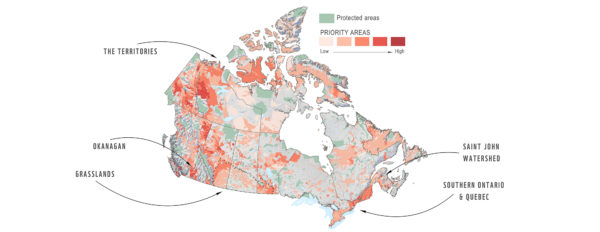Five Canadian regions that need wilderness protection now
In response to Netflix’s recent nature documentary Our Planet that was co-produced with WWF, or the recent UN warning that one million species are at risk of extinction, you might be wondering what can be done to help wildlife here in Canada.
Half of Canada’s monitored species are in decline, primarily due to habitat loss. Wildlife simply can’t survive with increasingly degraded or destroyed habitats. They need space to find food, mate, migrate and raise their young. Increasingly, they’re having a harder time finding that space.
Protected areas do more than just safeguard wildlife. They also serve as a tool to protect carbon-rich ecosystems such as forests, soils and peatbogs that keep carbon out of the atmosphere.
Canada has committed to protecting at least 17 per cent of terrestrial space and inland waters by 2020. But what are the best places to protect?
WWF-Canada’s new Wildlife Protection Assessment online report identified five priority regions for protection. These regions are among the least protected in Canada, yet are the most important for at-risk species, climate adaptation and carbon storage. By protecting these areas, we can simultaneously combat the dual crises of wildlife loss and climate change.
NORTHERN TERRITORIES
Grizzly bears, barren-ground caribou and wood bison call the Arctic tundra and taiga home. Unprotected habitats in the territories range from mountains to valleys and include major free-flowing rivers. The territories have the highest proportion of unprotected habitats in the country while facing increasing disturbance from climate change and resource extraction. More specifically, the Yukon extending into the Northwest Territories contains high levels of natural carbon storage, important climate refuges and high numbers of at-risk species.
OKANAGAN VALLEY
British Columbia’s southern interior is home to unique wildlife like the pallid bat and the desert nightsnake. The mix of grasslands, forests, desert-like areas and rich riparian ecosystems provides highly diverse habitats that host many of the province’s at-risk species. Unfortunately, these habitats are not adequately protected. Expanding human population, plus related road and housing infrastructure and agriculture development have added pressure to the region. In addition to being a species hotspot, the Okanagan contains areas that have high levels of forest biomass and climate refuges.
PRAIRIE GRASSLANDS
Grasslands are considered one of the most threatened ecosystems in the world and, for the most part, are inadequately or not at all protected. They are home to some of the highest numbers of at-risk species in Canada, including the swift fox and Sprague’s pipit. While protection of the grasslands is critical to reversing the decline of our most threatened species, other ecosystems within the prairie provinces contain high densities of soil carbon and forest biomass – important carbon stores.
SOUTHERN ONTARIO & QUEBEC
Southern Ontario and Quebec are highly developed for urban and agricultural needs. Nearly the entire region is either unprotected or very poorly protected, and it is also home to high densities of at-risk species, like the snapping turtle and Jefferson salamander. Increasing privatization of land means that large, intact and connected protected areas are more difficult to implement, so complimentary conservation options, like habitat restoration, may be necessary to give wildlife the protection they need.
SAINT JOHN RIVER WATERSHED
New Brunswick has one of the worst ecological representation scores in Canada, with only one per cent of habitats adequately protected. The Saint John River – or Wolastoq – winds across the province as a maze of blind bays, tributaries, lakes and marshlands, providing essential habitat to at-risk wood turtles and shortnose sturgeon. In addition to being home to many at-risk species, some areas of the region contain significant carbon stores, and climate refuges. These values, combined with increasing human pressures on the landscape, make this region a priority for protection.
Learn more about habitat protection in your area by visiting wwf.ca/habitatcrisis. You can also listen to our podcast featuring the scientists involved with the Wildlife Protection Assessment.


